Chikungunya, Influenza, Nipah, and Semliki Forest Chimeric Viruses with Vesicular Stomatitis Virus: Actions in the Brain
- PMID: 28077641
- PMCID: PMC5331823
- DOI: 10.1128/JVI.02154-16
Chikungunya, Influenza, Nipah, and Semliki Forest Chimeric Viruses with Vesicular Stomatitis Virus: Actions in the Brain
Abstract
Recombinant vesicular stomatitis virus (VSV)-based chimeric viruses that include genes from other viruses show promise as vaccines and oncolytic viruses. However, the critical safety concern is the neurotropic nature conveyed by the VSV glycoprotein. VSVs that include the VSV glycoprotein (G) gene, even in most recombinant attenuated strains, can still show substantial adverse or lethal actions in the brain. Here, we test 4 chimeric viruses in the brain, including those in which glycoprotein genes from Nipah, chikungunya (CHIKV), and influenza H5N1 viruses were substituted for the VSV glycoprotein gene. We also test a virus-like vesicle (VLV) in which the VSV glycoprotein gene is expressed from a replicon encoding the nonstructural proteins of Semliki Forest virus. VSVΔG-CHIKV, VSVΔG-H5N1, and VLV were all safe in the adult mouse brain, as were VSVΔG viruses expressing either the Nipah F or G glycoprotein. In contrast, a complementing pair of VSVΔG viruses expressing Nipah G and F glycoproteins were lethal within the brain within a surprisingly short time frame of 2 days. Intranasal inoculation in postnatal day 14 mice with VSVΔG-CHIKV or VLV evoked no adverse response, whereas VSVΔG-H5N1 by this route was lethal in most mice. A key immune mechanism underlying the safety of VSVΔG-CHIKV, VSVΔG-H5N1, and VLV in the adult brain was the type I interferon response; all three viruses were lethal in the brains of adult mice lacking the interferon receptor, suggesting that the viruses can infect and replicate and spread in brain cells if not blocked by interferon-stimulated genes within the brain.IMPORTANCE Vesicular stomatitis virus (VSV) shows considerable promise both as a vaccine vector and as an oncolytic virus. The greatest limitation of VSV is that it is highly neurotropic and can be lethal within the brain. The neurotropism can be mostly attributed to the VSV G glycoprotein. Here, we test 4 chimeric viruses of VSV with glycoprotein genes from Nipah, chikungunya, and influenza viruses and nonstructural genes from Semliki Forest virus. Two of the four, VSVΔG-CHIKV and VLV, show substantially attenuated neurotropism and were safe in the healthy adult mouse brain. VSVΔG-H5N1 was safe in the adult brain but lethal in the younger brain. VSVΔG Nipah F+G was even more neurotropic than wild-type VSV, evoking a rapid lethal response in the adult brain. These results suggest that while chimeric VSVs show promise, each must be tested with both intranasal and intracranial administration to ensure the absence of lethal neurotropism.
Keywords: Nipah virus; blood-brain barrier; brain; chikungunya; influenza virus; neurotropic viruses; vesicular stomatitis virus; viral vaccine.
Copyright © 2017 American Society for Microbiology.
Figures

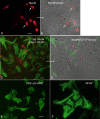
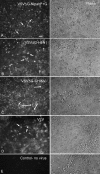




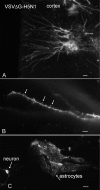
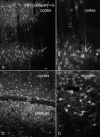
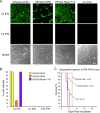
Similar articles
-
A viable recombinant rhabdovirus lacking its glycoprotein gene and expressing influenza virus hemagglutinin and neuraminidase is a potent influenza vaccine.J Virol. 2015 Mar;89(5):2820-30. doi: 10.1128/JVI.03246-14. Epub 2014 Dec 24. J Virol. 2015. PMID: 25540378 Free PMC article.
-
Chikungunya-vesicular stomatitis chimeric virus targets and eliminates brain tumors.Virology. 2018 Sep;522:244-259. doi: 10.1016/j.virol.2018.06.018. Epub 2018 Jul 26. Virology. 2018. PMID: 30055515 Free PMC article.
-
A chimeric vesiculo/alphavirus is an effective alphavirus vaccine.J Virol. 2013 Jan;87(1):395-402. doi: 10.1128/JVI.01860-12. Epub 2012 Oct 17. J Virol. 2013. PMID: 23077320 Free PMC article.
-
A Brighton Collaboration standardized template with key considerations for a benefit/risk assessment for the emergent vesicular stomatitis virus (VSV) viral vector vaccine for Lassa fever.Vaccine. 2025 Jun 11;58:127137. doi: 10.1016/j.vaccine.2025.127137. Epub 2025 May 13. Vaccine. 2025. PMID: 40367816 Review.
-
Live virus vaccines based on a vesicular stomatitis virus (VSV) backbone: Standardized template with key considerations for a risk/benefit assessment.Vaccine. 2016 Dec 12;34(51):6597-6609. doi: 10.1016/j.vaccine.2016.06.071. Epub 2016 Jul 6. Vaccine. 2016. PMID: 27395563 Free PMC article. Review.
Cited by
-
Recombinant vesicular stomatitis virus vector vaccines for WHO blueprint priority pathogens.Hum Vaccin Immunother. 2019;15(10):2269-2285. doi: 10.1080/21645515.2019.1649532. Epub 2019 Sep 5. Hum Vaccin Immunother. 2019. PMID: 31368826 Free PMC article. Review.
-
Development of a neutralization assay using a vesicular stomatitis virus expressing Nipah virus glycoprotein and a fluorescent protein.Virology. 2023 Oct;587:109858. doi: 10.1016/j.virol.2023.109858. Epub 2023 Aug 2. Virology. 2023. PMID: 37544045 Free PMC article.
-
Viral vectored vaccines: design, development, preventive and therapeutic applications in human diseases.Signal Transduct Target Ther. 2023 Apr 7;8(1):149. doi: 10.1038/s41392-023-01408-5. Signal Transduct Target Ther. 2023. PMID: 37029123 Free PMC article. Review.
-
Recent advances in vesicular stomatitis virus-based oncolytic virotherapy: a 5-year update.J Gen Virol. 2017 Dec;98(12):2895-2911. doi: 10.1099/jgv.0.000980. J Gen Virol. 2017. PMID: 29143726 Free PMC article.
-
Ebola virus disease.Nat Rev Dis Primers. 2020 Feb 20;6(1):13. doi: 10.1038/s41572-020-0147-3. Nat Rev Dis Primers. 2020. PMID: 32080199 Free PMC article. Review.
References
-
- Chattopadhyay A, Park S, Delmas G, Suresh R, Senina S, Perlin DS, Rose JK. 2008. Single-dose, virus-vectored vaccine protection against Yersinia pestis challenge: CD4+ cells are required at the time of challenge for optimal protection. Vaccine 26:6329–6337. doi:10.1016/j.vaccine.2008.09.031. - DOI - PMC - PubMed
-
- Geisbert TW, Daddario-Dicaprio KM, Lewis MG, Geisbert JB, Grolla A, Leung A, Paragas J, Matthias L, Smith MA, Jones SM, Hensley LE, Feldmann H, Jahrling PB. 2008. Vesicular stomatitis virus-based Ebola vaccine is well-tolerated and protects immunocompromised nonhuman primates. PLoS Pathog 4:e1000225. doi:10.1371/journal.ppat.1000225. - DOI - PMC - PubMed
Publication types
MeSH terms
Substances
Grants and funding
LinkOut - more resources
Full Text Sources
Other Literature Sources
Molecular Biology Databases

